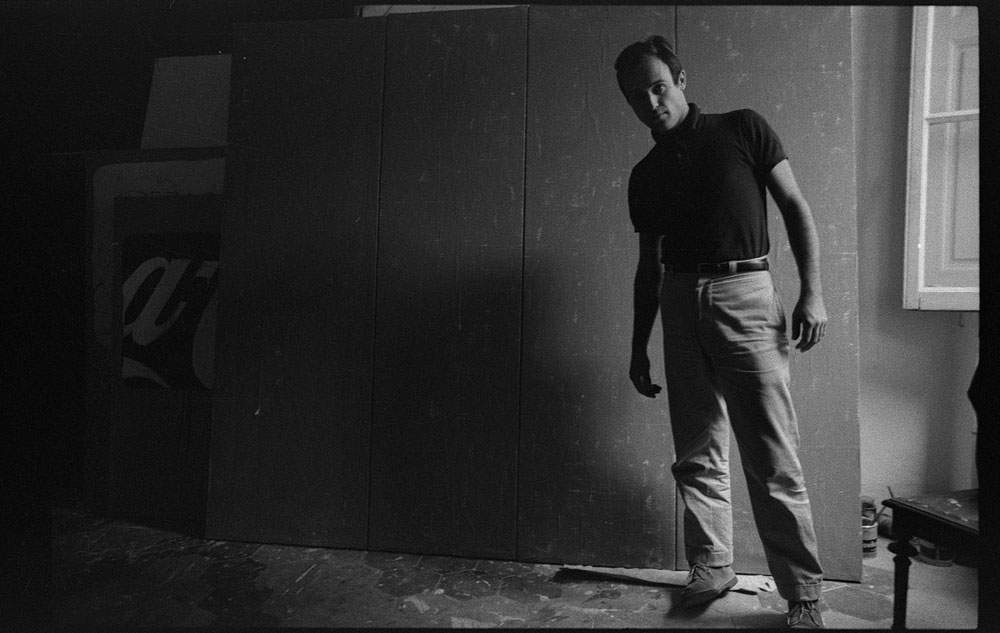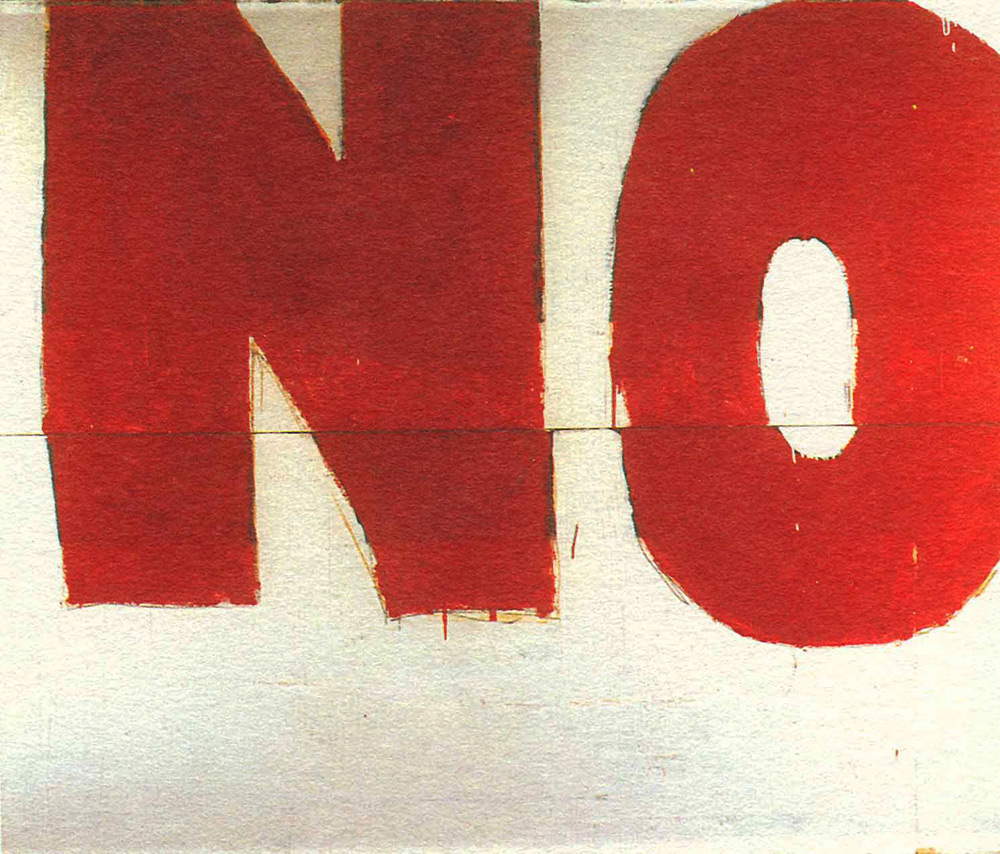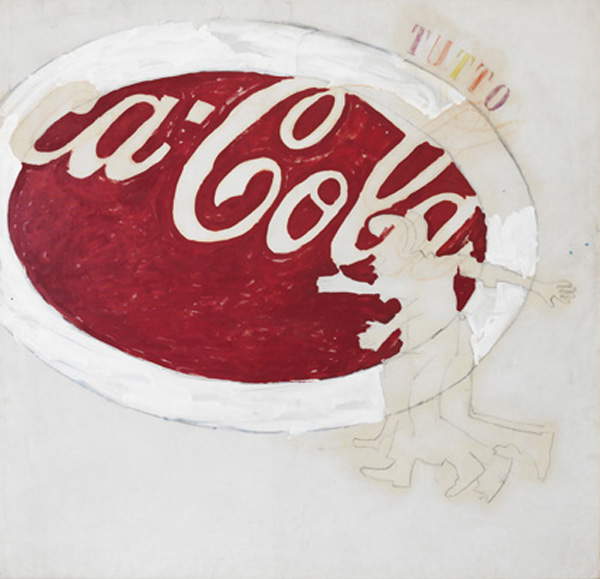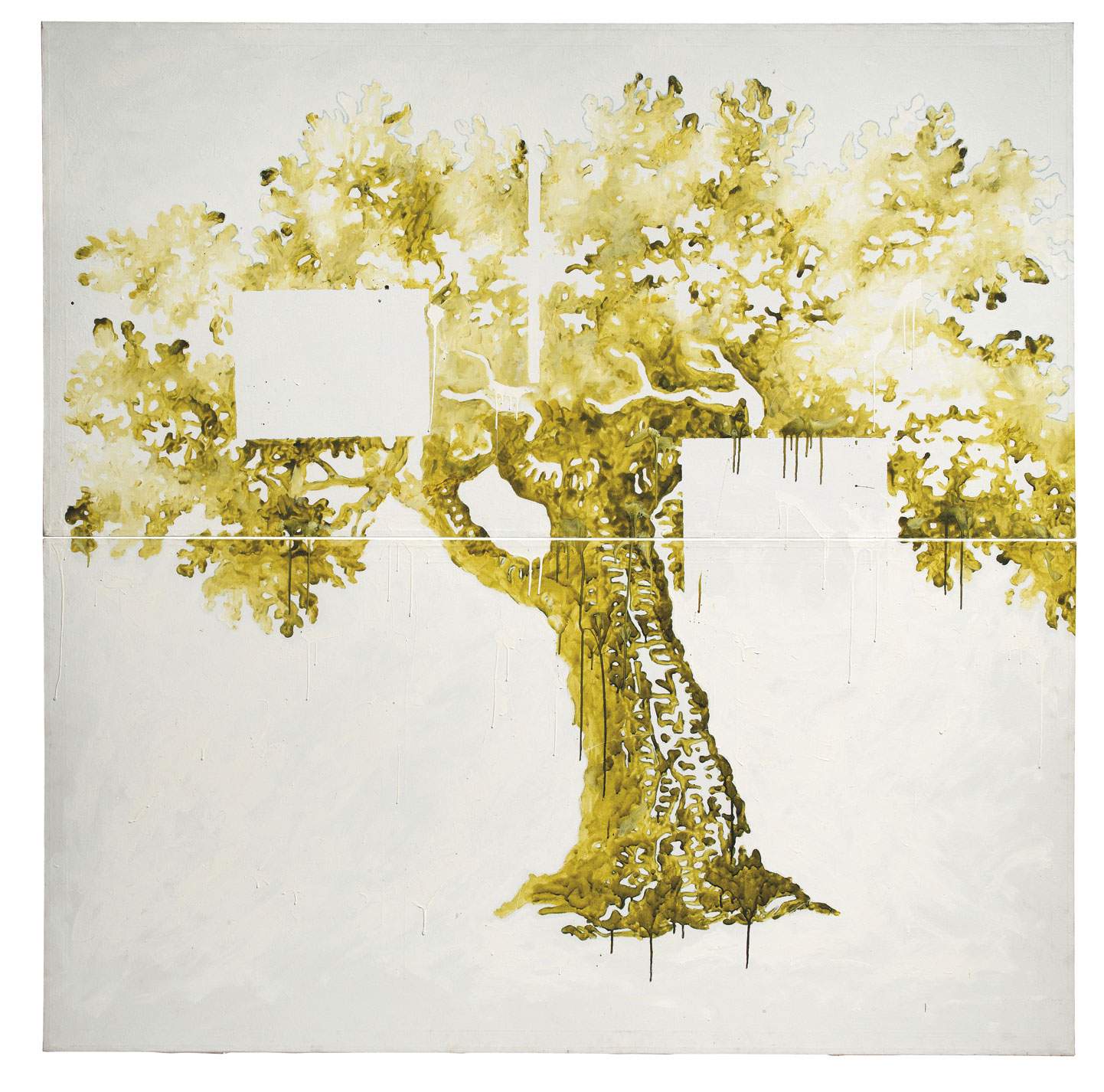Mario Schifano (Homs, 1934 - Rome, 1998) was one of the most important Italian artists on the national and international scene of the 1960s. An artist with a rebellious and biting soul, Mario Schifano to this day is considered one of the most prolific painters of the postwar period. Goffredo Parise described him as a “puma painter”: “A small puma whose musculature and outburst are not suspected, who leaves behind the sharp and mysterious imprint of elegance.” The artist is a kind of all-ItalianAndy Warhol, with an eccentric and multifaceted character, a lover of the good life and in love with his Rome. Around the figure of Mario Schifano, thanks to his extremely rich activity, revolved many works whose authenticity was not verified in the past: for this reason, a foundation was then established in his name(marioschifano.it), which is responsible for preserving, classifying and guarding the entire artistic heritage of the painter.
Mario Schifano is also known for his ties to music. During his time in Rome in the 1960s, the artist met Ettore Rosboch, a film producer. Through numerous trips to London, the two met the Rolling Stones, with whom they formed a deep friendship. Keith Richards and Mick Jagger also collaborated on his film Trilogy for a Massacre: all the band members assiduously attended parties held by Mario in his apartment in Rome, which were even attended by many important faces of Italian music such as Patty Pravo or faces from television such as Eleonora Giorgi. Mario’s two companions, Anita and Marianne, later became girlfriends of the very members of the band. Anita Pallenberg, initially engaged to the painter, became romantically linked some time later first with Brian Jones and later with Keith Richards. Marianne Faithfull, also engaged to Mario Schifano, became Mick Jagger’s partner just after the breakup. In 1969 the Rolling Stones, in honor of their friendship, dedicated the song Monkey Man to him.
Mario Schifano also shared with rock musicians... excesses... It is no mystery that the painter used drugs continuously. His personality and compulsive nature led him to drug addiction. He apparently had his first dealings with drugs in the United States where he first tried LSD, experimenting soon after with painting under the narcotic. In Rome, his apartment was the site of parties and meetings, frequently involving alcohol and drugs. His relationship with drug addiction was stormy and anguished. As reported in a Repubblica article written in the aftermath of his death(Schifano of the Scandals, Jan. 27, 1998) because of his addiction he ended up six times in prison, once in a criminal asylum and several times in a clinic for detoxification.
 |
| Mario Schifano in his studio in front of the work Something Else, Rome, 1962. Courtesy Mario Schifano Archive. |
Mario Schifano was born in Homs, a city in Libya, then Italian, on September 20, 1934. Soon after World War II ended, he moved to Italy with his family, specifically to Rome where he spent the rest of his life. Because of his controversial and defiant character he never finished school, immediately going to work. At first he was hired as a clerk but soon after became a restorer, following in his father’s footsteps, at the Etruscan Museum of Villa Giulia in Rome. Thanks to the latter assignment, Mario got closer to the world of art. In 1959 he exhibited his works for the first time in a solo show at the Galleria Appia Antica. His early paintings were influenced by Informal Art taking on characteristics similar to the movement such as strong materialism.
After the initial Informal period, he decided to join the collective called "La Scuola di Piazza del Popolo," a Roman artistic experiment of the 1960s that was joined by the likes of Tano Festa, Franco Angeli and Mimmo Rotella. Together with his companions in 1960 he exhibited a number of works in the group exhibition at the Salita. His initially informal painting style headed toward monochromatic painting: on the canvas covered with a single color, the artist applied glued papers, signs, letters of the alphabet and images of various kinds. This experience was a springboard to the critics, who from that moment began to acclaim him, making him win awards such as: the Premio Lissone (1961), La Nuova Figurazione (1963) and the Premio Fiorino.
A gathering point for the group became the Caffè Rosati, which hosted meetings and artistic debates several times, thus becoming a point of reference for artists of those years including Pier Paolo Pasolini, Alberto Moravi and Federico Fellini. While hanging out at the bar he met Anita Pallenberg, a young model who soon became his girlfriend. Together with his companion he traveled to the United States where he met Andy Warhol, the father of Pop Art. In New York, Schifano attended the Factory (the studio and meeting place of Andy Warhol and his collaborators) and taking part in 1963 in the exhibition New Realists organized by the Sidney Janis Gallery (a collective of artists belonging to Pop Art and Nouveau Realisme). At the gallery he had the pleasure of exhibiting his works alongside the main exponents of Nouveau Réalisme such as Christo, Klein and his friend and colleague Mimmo Rotella. It was precisely in the USA that Mario Schifano came into contact with the first drugs, thus beginning his first experiments under hallucinogenic effects.
After the American experience he exhibited in numerous shows throughout Europe in cities such as Paris, Milan, Rome and Venice. In the latter city, in 1964, he participated in the 32nd Art Biennale exhibiting a selection of paintings traceable to his early experiments with Anemic Landscapes, paintings that were extraordinarily successful. In Paesaggio Anemico I (1964) he deconstructed the idea of landscape, thus distorting the concept itself. The painting represents the breaking point with monochromatic painting. The same year saw the release of his first experimental films, Round Trip and Reflex. In 1965 the artist helped found “Le Stelle di Mario Schifano”, a band with a psychedelic rock genre. Mario Schifano thus established himself as a multifaceted and versatile artist, capable of ranging in various fields and producing through multiple art forms. Shortly after the creation of the band, the artist left the musical group to devote himself only to pictorial activity while still maintaining good relations with both the world of music and the world of film. Thus, in 1967 he made some scenes for Marco Ferreri’s L’Harem and the following year, in 1968, he produced the Trilogy for a Massacre (Satellite, Human not Human, Transplantation, Consumption, Death by Franco Brocani).
Between the 1970s and 1980s the artist became more and more established on the national scene, gaining more and more credibility. It was during these years that he briefly abandoned painting, which according to his thinking was now obsolete, opting for innovative techniques such as silkscreen printing. He returned to painting several times despite his thinking, but his love of experimentation led him to experiment with new artistic products using media and television. Characteristic of this period were the computerized canvases, with which Schifano processed images taken from the computer and brought them back on emulsified canvases. After several drug-related problems, he was finally reinstated by conviction for illegal possession of drugs in 1997. He died the following year, on Jan. 26, 1998 at Rome’s Santo Spirito Hospital, of a heart attack.
 |
| Mario Schifano, No (1960; enamel on canvas, 160 �? 200 cm; Private collection) |
 |
| Mario Schifano, Comrade Compan ions (1968; enamel and spray on canvas and perspex, 200 �? 300 cm; Private collection, Courtesy Fondazione Marconi, Milan) |
 |
| Mario Schifano, Anemic Landscape I (1964; pencil and enamel on canvas, diptych, 220 �? 200 cm) |
Mario Schifano’s painting style, during the first years of his career, was influenced by ’Informal art, and his works were thus marked by the rejection of form and the domination of materiality on the canvas. After this early period, Mario’s painting focused toward a monochromatic path, from which he soon turned away, repudiating it. In fact, years later the artist declared, “I thought that painting meant starting from something absolutely primary. The first paintings only yellow with nothing in them, empty images, did not want to say anything. They went beyond, or this way, of any cultural intention. They wanted to be themselves. Making a yellow painting was just making a yellow painting.”
With his early monochromatic paintings in which he applied glued letters or papers, the artist quickly achieved affirmation and fame. Before he achieved international success, the series devoted to anemic landscapes was of particular interest, where he carried out radical experiments deconstructing the landscape image. During the late 1960s he approached worlds as distant from painting as cinema, producing independent films, or as music, founding the musical group “Le stelle di Mario Schifano.” Years later he brought Pop Art to Italy by working on works such as billboards, lettering and advertising logos such as those of Coca Cola or Esso. It was during this period that the artist turned to new innovative tools. Screen printing enabled him to produce several works in a short time, with excellent results, including economic ones. Among the painter’s most famous works, it is important to mention the emulsified canvases (TV Landscapes), in which he repurposed everyday television images by reworking the scene only with color. His passion toward art and his versatile talent led him to carry out numerous artistic experiments.
To trace a possible path through Mario Schifano’s art, one could start with Paesaggio Anemico I, one of the earliest canvases in the artist’s eponymous series, in which monochromatic painting is abandoned in favor of landscape themes.
The work was first exhibited at the 32nd Venice Biennale in 1964: the painting represents, in short, the deconstruction of a typical landscape representation. The canvas, mainly covered with a blue hue symbolizing the clear sky, is covered with white patches corresponding to clouds. In addition, he adds red-colored geometric elements on the canvas that emphasize the painting’s mechanicality. Commenting on the work Mario stated, “I have tried to work with images that everyone sees or has seen, highlighting their essence so that their germinal and primary possibilities can emerge. Looking is the first action, then one lingers.”
Later, Influenced by American Pop Art, which he came into contact with on his trip to the United States, meeting and hanging out with Andy Warhol in person, Mario returned to Italy and at the turn of the 1960s and 1970s produced a series of Pop paintings. One example among all is Segno di Energia (1977-1980), where the painter depicts the logo of the very important oil company Esso, thus beginning a series reproduction of similar works among them. Andy Warhol, his inspirer and father of Pop Art, in America years earlier had proposed serial reproductions and multiple versions of Campbell’s soup: among the favorite logos represented on Mario Schifano’s canvases are the Esso and Coca Cola logos.
Among Mario Schifano’s late works we also find the famous TV Landscapes. In the last period of his life he came in contact with the world of television from which he was inspired to create these canvases of his. Mario thus became interested in multimedia and new media. The series has the same setting in each painting: the bulk of a television set frames the scenes of the different paintings, where each work precisely captures a still image of a scene, immortalizing it as if it were a photograph or a frame of a film. Black and white is contrasted with and added to brightly colored, psychedelic paint that gives the canvases a greater sense of disturbance and unreality. Finally, the artist’s experimental films deserve a mention, including Human Not Human from 1971, which of these films is certainly the most popular and iconic. As anticipated, the film is part of the Trilogy for a Massacre: The feature film participated in the 30th Venice International Film Festival. The film, produced in 1969, was resubmitted at the sixty-sixth Venice International Film Festival thanks to the restoration of the film in 2009 by the Cineteca Nazionale. Umano non Umano focuses on the ’incommunicability ofthe contemporary world by representing a snapshot of Italy in the 1970s. In fact, the film sees the juxtaposition of bourgeois salons with workers’ revolts.
 |
| Mario Schifano, Coca Cola (mixed media on canvas, 200 x 205.5 cm; Rovereto, Mart, private collection deposit) |
 |
| Mario Schifano, En plein air (mid-1970s; enamel on two canvases, 200 x 200 cm; Rimini, PART) |
The painter’s artistic activity was extremely rich and prolific; in fact, during the course of his life he had the opportunity to participate in numerous solo and group exhibitions. To this day, the foundation in his name is in charge of safeguarding the master’s works, although the institution is not open to the public preserve several of the artist’s works.
Several of his works are preserved in important Italian museums such as the National Gallery of Modern and Contemporary Art inRome, the Museum of Contemporary Art in Rome (MACRO), the Museum of Modern Art in Bologna (MAMbo), and at the Society for Fine Arts and Permanent Exhibition in Milan.
 |
| Mario Schifano. Life and works of the "cougar painter" |
Warning: the translation into English of the original Italian article was created using automatic tools. We undertake to review all articles, but we do not guarantee the total absence of inaccuracies in the translation due to the program. You can find the original by clicking on the ITA button. If you find any mistake,please contact us.